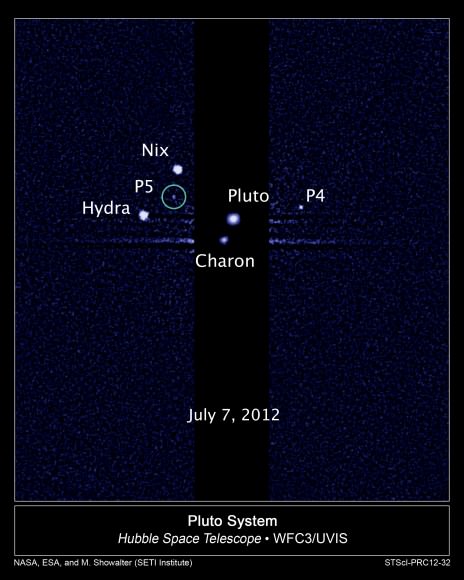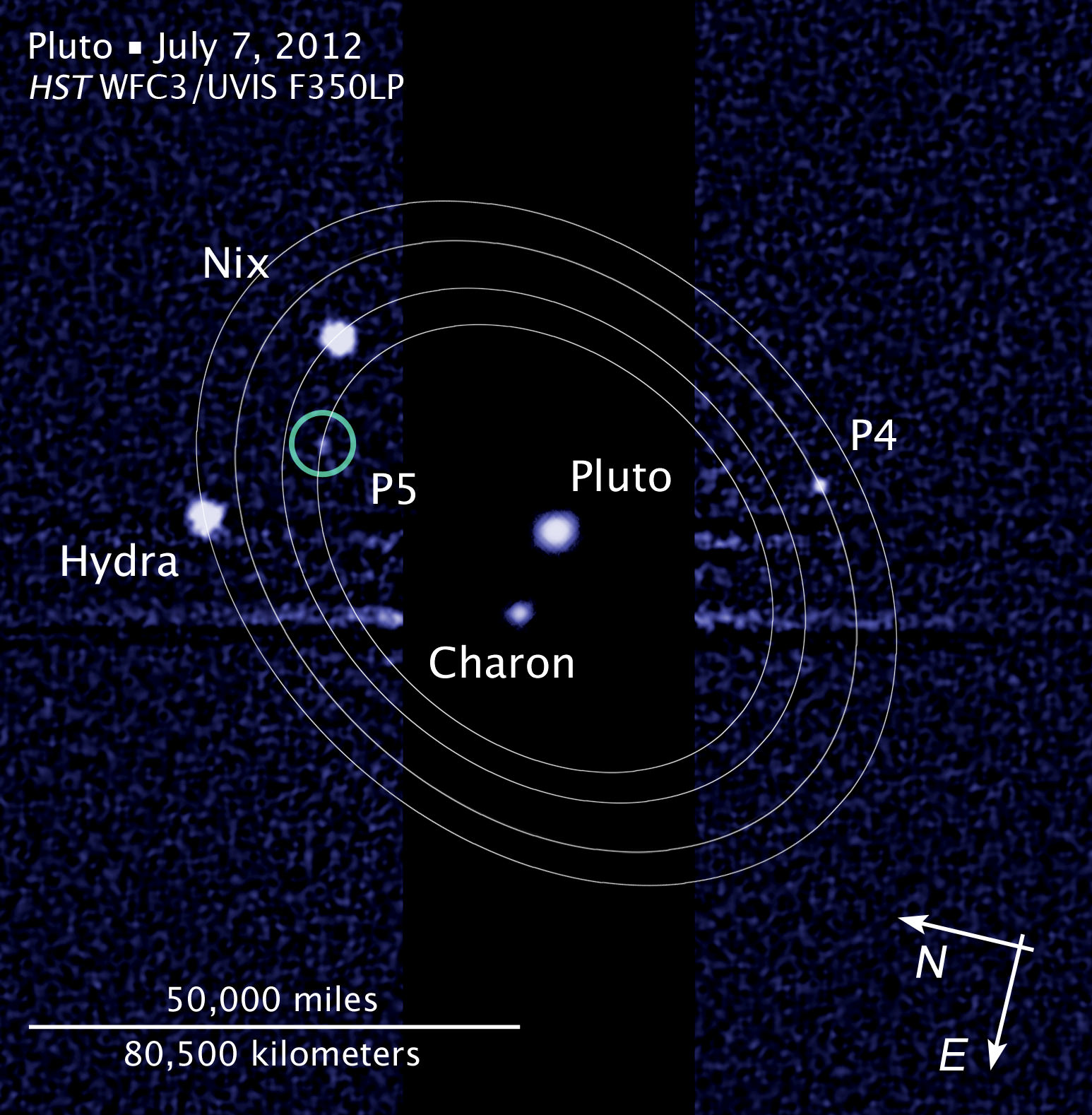Following an intense 18 month study to determine if NASA’s New Horizons spacecraft faced potentially destructive impact hazards during its planned 2015 flyby of the Pluto binary planet system, the mission team has decided to ‘stay the course’ – and stick with the originally planned trajectory because the danger posed by dust and debris is much less than feared.
The impact assessment study was conducted because the Pluto system was discovered to be much more complex – and thus even more scientifically compelling – after New Horizons was launched in January 2006 from Cape Canaveral in Florida.
Two years ago researchers using the iconic Hubble Space Telescope discovered two new moons orbiting around Pluto, bringing the total to 5 moons!
It was feared that debris hitting the moons could have created dangerous dust clouds that in turn would slam into and damage the spacecraft as it zoomed past Pluto at speeds of some 30,000 miles per hour (more than 48,000 kilometers per hour) in July 2015.
“We found that loss of the New Horizons mission by dust impacting the spacecraft is very unlikely, and we expect to follow the nominal, or baseline, mission timeline that we’ve been refining over the past few years,” says New Horizons Project Scientist Hal Weaver, of the Johns Hopkins University Applied Physics Laboratory, in a statement.
After both the team and an independent review board and NASA thoroughly analyzed the data, it was determined that New Horizons has only a 0.3 percent chance of suffering a mission destroying dust impact event using the baseline trajectory.

The 0.3 percent probability of mission loss is far less than some earlier estimates.
This is really good news because the team can focus most of its efforts on developing the flyby encounter science plan when New Horizons swoops to within about 12,500 kilometers (nearly 7,800 miles) of Pluto’s surface.
Pluto forms a “double planet” system with Charon, its largest moon. Charon is half the size of Pluto.
But the team will still expend some effort on developing alternative trajectories – known as SHBOTs, short for Safe Haven by Other Trajectories, just in case new information arises from the ships camera observations that would force a change in plans as New Horizons sails ever closer to Pluto.
“Still, we’ll be ready with two alternative timelines, in the event that the impact risk turns out to be greater than we think,” says Weaver.
Indeed the team, led by Principal Investigator Alan Stern, of the Southwest Research Institute is finalizing the encounter plan this month and plans a rehearsal in July of the most critical nine-day segment of the baseline flyby trajectory.
New Horizons will perform the first reconnaissance of Pluto and Charon in July 2015. The “double planet” is the last planet in our solar system to be visited by a spacecraft from Earth.
And New Horizons doesn’t’ stop at Pluto. The goal is to explore one or more of the icy Kuiper Belt Objects (KBO’s) further out in the Solar System.
The team will use the Pluto flyby to redirect New Horizons to a KBO that is yet to be identified.
And don’t forget to “Send Your Name to Mars” aboard NASA’s MAVEN orbiter- details here. Deadline: July 1, 2013. Launch: Nov. 18, 2013
…………….
Learn more about Pluto, Mars, Curiosity, Opportunity, MAVEN, LADEE and NASA missions at Ken’s upcoming lecture presentations
June 23: “Send your Name to Mars on MAVEN” and “CIBER Astro Sat, LADEE Lunar & Antares Rocket Launches from Virginia”; Rodeway Inn, Chincoteague, VA, 8 PM


I hear the risk is low because of the wonderful job Charon does of sweeping away debris.
Does anyone know if there is anything planned for New Horizons after the KBO phase? Something like the Voyagers’ extended study of the outer solar system?
Good news! I must say though, I doubt New Horizons will pass anything of any interest in the Kuiper Belt before its batteries run out. If it did, it would be like hitting the jackpot.
IRC, they expect to get in favourable position for observation of at least a couple more known trans-Neptunians.
New Horizons is much more technologically advanced than Voyager 1 or 2, and both are still contributing meaningful scientific observations. I’m keeping my fingers crossed that New Horizons will perform similarly.
The two Voyager satellites are grandpa and grandma. You are correct. They both are still contributing providing great info. 😉
My favorite movie like the original-1st Star Trek series To me, that one Star Trek movie about v’ger was the best ever made. The concept and human machine relations were/are/is so kool. I would of given anything to of been that dude who joined as ‘one’ with V’ger’s human female turned mind-probe. She was so damn fine! What GREAT taste Ve’ger has!…LUCKEY!…;-) …lol…
New Horizons is powered with a radioisotope thermoelectric generator (RTG); it provided 250 W of power at launch, which drops by approximately 5% every 4 years through radioactive decay; it will provide 200 W by the time of the Pluto system encounter in 2015. There are no on-board batteries .
How long do they expect it to remain operational? Best case scenario.
I dont know the answer to your question, but i can calculate that if the operating minimum power requirement of the system is 70W, it will take about 100 years from launch before the RPG drops to that level.
New Horizons is expected to continue its mission into the Kuiper belt until the year 2026, at which point it will be approximately 55 AU from the Sun – beyond that point the communications link becomes too weak, and the RTG wattage will have decayed significantly enough to hinder observations.
Just for perspective, both Voyager probes are also using RTGs for their power source. They are still providing science decades after launch. While I don’t know off hand if NH is using a smaller RTG, it should still provide at least half the time of the Voyagers.
I am hoping that the RTG will permit them to keep on some of the optical systems so that we may actually get some shots out beyond the KBO objects and SEE what is out there rather than just remote sensing of radiation and such which doesn’t really tell us much about the granularity of that area of space
I had no idea they considered this a binary system now ? When did Charon get an upgrade from simply Pluto’s moon ?
The IAU has not yet finalized a definition for binary dwarf planets.
The New Horizons spacecraft will begin observing Pluto six months prior to the closest approach. Lets hope all goes well and the data stream remains coherent for the whole encounter!
We have sent probes through the rings of Saturn. This fear was always overblown
Excellent news, but i am curious why they have not developed a trajectory, as well as using the onboard fuel availability, to put NH into an extended orbit of the system by using gravitational assistance from the various members of the system. It might take a couple of years but that would increase study time and likely provide better science to answer some very important questions about how this system arose.
Does NH’s trajectory follow the same path as either of the Voyagers?